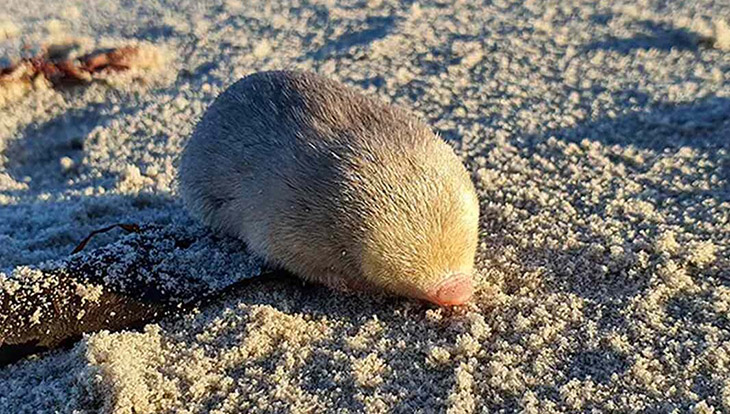
In a noteworthy triumph for conservationists, a diminutive species of golden mole, known as De Winton’s golden mole, has emerged from the shadows in South Africa after eluding scientific observation since 1936.
The re-discovery owes its success to a tenacious group of conservationists and an unlikely ally – a specially trained sniffer dog named Jessie.
Initially documented in Port Nolloth in 1936, De Winton’s golden mole left behind a void of information, with no photographs or detailed behavioral accounts. This small, blind mammal navigates its subterranean world by detecting vibrations through the tissue in its oversized nose, making it an elusive target for traditional search methods.
Facing the challenge of training a sniffer dog without a physical specimen, the team, led by Cobus Theron, program manager at South Africa’s Endangered Wildlife Trust (EWT), took an ingenious approach. They trained a border collie named Jessie to detect the scent of another golden mole species from the region, reasoning that De Winton’s mole might share a similar odor.
Compounding the difficulty was the mole’s habitat – shifting sand dunes. Due to the constant movement of sand caused by wind, the moles’ tracks and dens are easily erased. This, coupled with the absence of historical samples, detailed descriptions, or DNA, posed a formidable challenge in identifying De Winton’s Golden Mole.
Fortune smiled upon the conservation team during their 2022 expedition to Port Nolloth. A rainstorm had frozen the tracks of the moles in the wet sand, preserving the evidence. Surprisingly, Jessie showed no interest in the scene, indicating that the tracks belonged to a mole whose scent she did not recognize.
“The team collected more than 100 samples from the sand to take back to the lab for eDNA—short for environmental DNA—analysis,” writes Re:wild, one of the organizations that supported the effort.
“eDNA focuses specifically on the nuclear or mitochondrial DNA animals leave behind as they move through their environment, including hair cells, skin cells, and scat.”
The organization Re:wild played a crucial role in supporting the rediscovery through its innovative “25 Most Wanted” list, which identifies species lost to science, organizes expeditions to find them, and funds conservation efforts based on the publicity generated by the rediscoveries. De Winton’s golden mole now stands as the 12th species removed from their list.
The breakthrough came when the team utilized environmental DNA (eDNA) sequences, comparing mitochondrial DNA from the preserved specimen to a mole held at the Port Nolloth Museum, confirming a match. This molecular evidence provided the elusive confirmation needed for the reclassification.
Samantha Mynhardt, a conservation genetics researcher at the Endangered Wildlife Trust says, “It’s been so exciting for me to make this discovery alongside a group of people with a shared interest and vision for golden moles to raise awareness about their presence, about their plight.”
The broader significance of such rediscoveries lies in their contribution to the fight against the global biodiversity crisis. Often overshadowed by the more charismatic megafauna, small and seemingly inconspicuous species like De Winton’s golden mole play a pivotal role in maintaining healthy ecosystems.
The ongoing “6th mass extinction” highlights the urgent need to protect and conserve these lesser-known species, as their survival ensures the resilience and balance of our planet’s intricate web of life.
Team leader, Theron, said, “I think it’s just fantastic that in 2023 we can still rediscover species. All of our stories around conservation are doom and gloom. Here we have an opportunity to say that, actually, there are opportunities to make change.”
What are your thoughts? Please comment below and share this news!
True Activist / Report a typo


